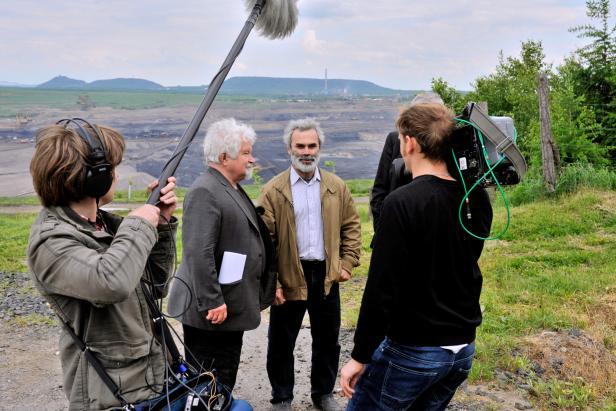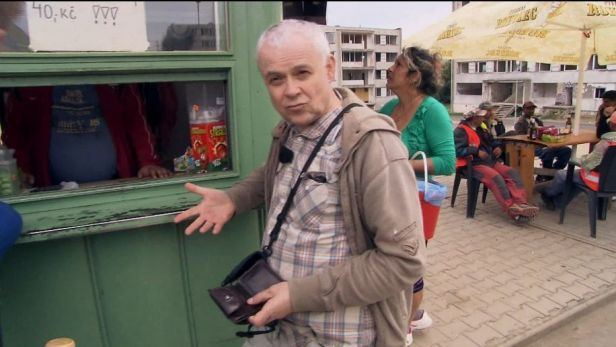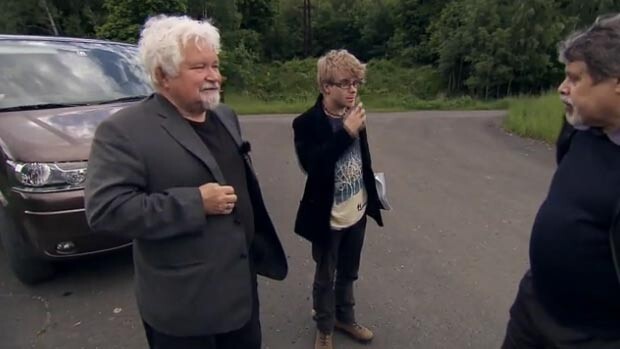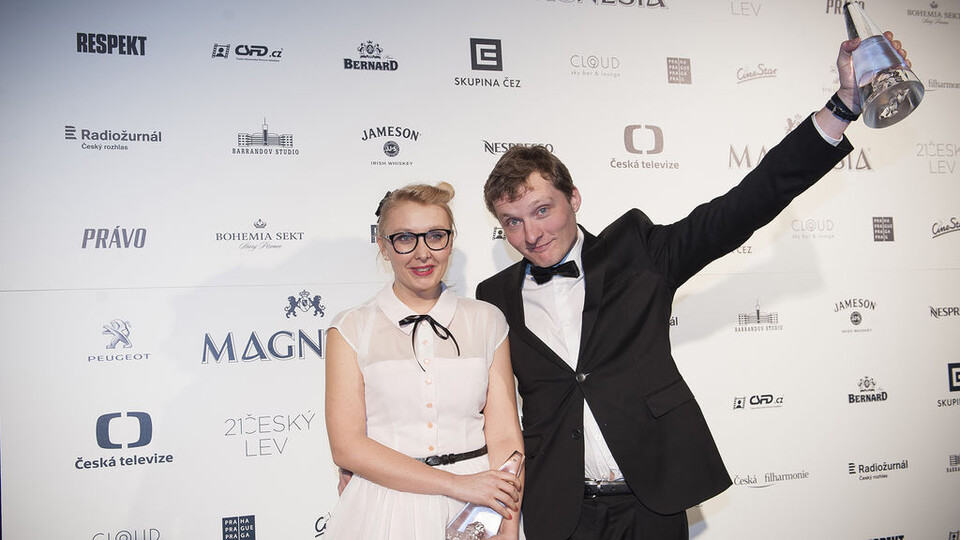Between Creative Documentary and Journalism
The Czech society lives in a strange collision with its political representation. While politics is a synonym of daylight robbery and unscrupulousness, politicians perceive the common people as a mass perfectly manipulated by the media and prefer not to speak to the media at all. This results in a tension between the political elites on one hand and the society on the other, and primarily in the emergence of an imaginary wall which does not allow either of the parties to look at politics and its impact on our lives from a more universal perspective. Kamila Zlatušková decided to explore this wall by producing ten 30-minute documentaries about the ex-premiers of the Czech Republic based on a treatment by students of the Department of Documentary Film at Prague’s FAMU. How did the students succeed in getting under the skin of people who have gone through the most powerful executive position in our country? Did they manage to break the barriers?
The theme of the series has a strong potential to address a wide range of viewers coveting the fates of the powerful. The directors of the series naturally try to win them by all means. For instance, the media said that the filmmakers managed to get unexpected confessions out of Stanislav Gross. Press releases claim that the series is documentary mainly because it combines an “original perspective” and “current” opinion and is based on confrontation. Its goal was to shatter media myths. Such claims raise expectations; unfortunately, reality rather seems to lag behind them. Even in case of the parts dealing with premiers from the 1990s, the young and go-getting documentarists untouched by the times did not manage to convince the ex-premiers to join them in the “myth shattering” process.
The political preferences of the viewers definitely play an important role in the reflection of the series. For that matter, political preferences can also be felt from some of the directors, sometimes resulting in failed attempts to ask about the controversial aspects of the political careers of the ex-premiers or to let the angry people of Prague’s streets tell the story. Some of the films thus completely conform to the media clash between the right and the left, without representing a crucial threat for the established mythology of either of the two camps. This is obvious in the part about Jiří Paroubek who is introduced as a strange monster; a technologist of power; which almost revives the strategy of the pre-election campaigns of ODS and TOP 09 at the times when Paroubek opposed them as the leader of ČSSD.
This is what makes those films whose confrontation is based on the retrospective reflection of the real political steps and laws enforced by the given politicians even more valuable. For instance, in the portrait of Petr Pithart, director Jaroslav Kratochvíl travels to North Bohemia to evaluate one of the most crucial decisions of the first Czech post-November government to legislate coal mining limits. The period players as well as the people who are confronted with the limits at various positions today and who are part of today’s debate about their breaking meet on the edge of the mine. Kratochvíl has put together the strongest set of eye-witnesses, ranging from government members through construction workers of the former Škoda car plant (on the privatization of which Pithart and his ministers illustrate their way of privatization whose results were so different from the results of the voucher privatization) to the then management of North Bohemia Coal Mines. The confrontation is also successful due to the fact that Pithart speaks openly about himself, is able of self-reflection, which is likeable, and has no problem revealing the background and circumstances of their decisions at the time. This part of the series is not distinctive in terms of form; it could even be labelled as journalistic; however, with a side note that if Czech journalism was like this we would know much more about politics today.

Ex-Premiers
A similar impression is achieved by the portrait of Vladimír Špidla made by Martin Kohout, offering a completely open discussion of the background of the departure of Miloš Zeman from the leadership of ČSSD, his failed presidential candidacy and the general strategies of the then government, focused on the successful entry to the EU and the kick-starting of necessary reforms. Špidla is also one of those who have no need to muddy the waters and discuss things backstage, rather actively communicating. Like Kratochvíl, Kohout, too, has arrived at a deeper understanding of the political reality of the period; one must also do him credit for capturing it in a casual and non-ornamental form. It is definitely an advantage to work with someone who is open to communication and who does not see his career through the prism of newspaper articles in Mladá Fronta daily; however, the two directors prove their assuredness in their choice of themes and cases to be explored, focusing on political decisions whose impact is discussed in the society until today, while providing a perspective that is analytical enough for them to look into the politicians’ contributions as well as their mistakes, seen from the distance we now have from Pithart’s and Špidla’s governments.
The other directors, however, were not as lucky with their politicians and thus had to face a difficult task; that of making a film about someone who does not want to be in it. There were three of them. Josef Tošovský, who has disappeared from public life many years ago and has shunned the media even during his premiership, has declined to participate. Director Viktor Portel addresses Tošovský’s then colleagues and makes use of archive material and interviews. This director, too, goes the analytical way. He introduces the circumstances of the formation of Tošovský’s government and its most substantial decisions, while searching for the personal coherence of Tošovský in a seemingly unwitting way. Archives are used by most of the other directors as well; however, Portel is the only one to let them really speak, selecting clips from period news as well as period commercials. To Portel, archives represent a way out of the media shortcut which creates the myth of the orderliness and uncorruptedness of caretaker governments around Tošovský’s government which came after the forced departure of Václav Klaus from his function in 1998.
The second politician to be absent is Václav Klaus. The unwillingness of his current colleagues to enable the shooting inspired Petra Nesvačilová to make a documentary detective story with the aim of tracking Klaus down. The problem Nesvačilová must deal with in the portrait of “her” ex-premier is that Klaus later became a president and his activities in both functions have radically divided the Czech society until today. The director gradually goes through the key stages of Klaus’ premiership from the dissolution of Czechoslovakia through the voucher privatization to the Sarajevo Assassination; however, she rather sticks to the level of a psychological profile of the missing ex-premier. She prefers to discuss the circumstances of Klaus’ political life rather than their content. The result does not tell us much new about the time of the rule of Václav Klaus, yet it shows us the present image of this personality. Nesvačilová starts out at the Klaus’ cottage and ends up at Czech Republic’s highest mountain Sněžka Klaus regularly goes to and can thus be met there. The director does not shove the camera in his face, does not provoke him, just asks him directly if he would like to shoot with her and thus breaks the barrier that surrounds the old gentleman, who may even have wanted to appear in the documentary. It is the very contrast between Klaus’ agile associates, with whom Nesvačilová holds absurd telephone conversations full of false promises and reluctance, and Klaus as a private person, that has an expressive value that gives the work a timeless character and proves that the filmmaker is able to stay on top of things.
The third non-participating politician is Petr Nečas; a man that feels that the media have slit his throat like that of a scapegoat; a man whose personal life has struck the Czech political scene in such a radical way that its previous course has been shaken to its foundations and is still shaking. The portrait of Nečas was made by Lukáš Senft who has hired an actor to impersonate Nečas and confront him with passers-by. The film radiates an effort to find a quick fix for the absence of the portrayed person. The director did not use the opportunity to look at Nečas’ rule through the prism of his real results but rather tried to reveal Nečas’ paranoia.

Ex-Premiers
In a way similar to Seifert’s, Robin Kvapil, too, hides behind a specific formal approach when making his portrait of Miloš Zeman. The weakest part of the series is full of clichés that are openly declared by Zeman; who is answering questions concerning the Bamberg affair and the Opposition Agreement that have been asked a thousand times before; and also presented by the director, cheerfully playing with Zeman’s “Spitting Image” latex mask. The film puts emphasis on the “unaesthetic” rule of Zeman and his ministerial crew, which is a standard today even in tabloid media.
In his portraits of Stanislav Gross and Jiří Paroubek, Jan Látal has decided to confront the two ex-premiers with their media image. In case of the former, he has the famous billboard saying “I really mean it” put up in the streets again, with the passers-by being able to write messages for the ex-politician. In case of the latter, the director goes to various cultural environments (the techno community, the IT professional who has launched the anti-Paroubek website as well as the young man who was the first to throw an egg at Paroubek) with a collection of the first 40 photographs generated by Google, asking them which of the photos characterizes Paroubek the most. Látal picks commentators from “right-wing” periodicals as analysts, thus amplifying the perception of Gross’ and Paroubek’s premiership through the pseudo-moral prism in a way in which their image has been unflinchingly defined for years.
The portrait of Mirek Topolánek was made by Apolena Rychlíková who has come up with the project together with Jakub Mahler. Communicative Topolánek makes use of his charisma and rhetoric skills not to allow anything that could bother him or that he could find unpleasant. At times, Rychlíková seems taken by surprise by his reactions, as if she feared he might walk away from the film, which he never does though.
This is symbolical for the whole series. On one hand, there is the opportunity to recollect ten personalities that demonstrably influenced the complicated transformation of the Czech society after 1989; on the other hand, we only get from them what they want to give us. Many of the directors do not know how to approach the politicians; should they conform to their pace and willingness to speak or camouflage their unwillingness by capturing their own reflections, their often boundless creativity? This situation is a true copy of the position the Czech public assumes towards the politicians, which hinders a more open and analytical dialogue.

Ex-Premiers
The Ex-Premiers series may have been great if the assignment were not so loose and if there was a generation of documentarists willing to leave the realm staked out by the journalists from Respekt weekly and Lidové noviny daily, or possibly Václav Bělohradský; for it is them who comments on the ex-premiers in most of the films. However, it is necessary to add that the Ex-Premiers series is great at least for the fact that it can help us decide what direction we should take in the documentary depiction of our recent political history. I would personally choose a way that is less creative yet has a greater information value.
Translated by Tereza Chocholová



